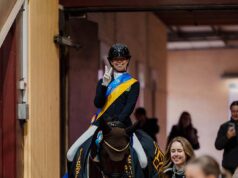By Jean Llewellyn
In a recent posting on the Norwegian-based website ‘World of Showjumping’, highly decorated and well-known international showjumper Rodrigo Pessoa speaks out, essentially addressing the issue of the Olympic format that was introduced in Tokyo 2020, and expresses his desire that the FEI sit up and take notice.
More jumping efforts, no drop score for national teams, and individual medals awarded ahead of the team competition. Three key factors that were introduced by the FEI, but certainly did not find favour among a great many from within the showjumping community. According to Pessoa: “I was actually the athlete representative on the FEI Jumping Committee at the time when this was decided, and I must say that myself and Rob Ehrens (Dutch chef d’equipe and member of the FEI Jumping Committee from 2015-2019) felt a little bit isolated there. We fought this decision very, very hard, with everything we could, but the FEI and the IOC wanted to go in a different direction, and we could not do anything about it.”
In fact, the Olympic format was the subject of a great deal of discussion over a four-year period, with Olympian Steve Guerdat also championing the cause of athletes during a presentation at the FEI Sports Forum. His voice was joined by Canadian Eric Lamaze, Cian O’Connor (IRL), Kevin Staut (FRA), and Max Kühner and Ludger Beerbaum from Germany, warning the FEI about the potentially disastrous consequences of the new format.
Pessoa continued by saying: “We riders knew that what happened in Tokyo was going to happen, because we’ve lived this sport from morning to night for almost our entire lives.” He added that Tokyo’s disasters were balanced by a degree of luck: “Course designer Santiago Varela did an unbelievable job, and the riders themselves did their job. They made the show, despite the had format. The sport was unbelieveable, but only because of the course builder, the horses, riders, and their staff – and not because of the format.
“In this day and age, there are three important parameters to take into account for all jumping championships. The number one priority is, of course, the welfare of the horse; secondly, we want to jump less in order to, three, get a great winner through top sport. This is the basis for what we now need to figure out. We need to find a way to reduce the amount of jumping, like the World Equestrian Games where the final four was cut as it was just too much for the horses and not in their best interests.
“If you look back at the horses that finished in the top 10 of the World Equestrian Games in Tryon, only two or three are still competing at the top level. Others have been struggling with injuries or are no longerin sport. So, we have to ask ourselves: How do we jump the horses less but still have tood sport. This is where we are going to put our heads together and come up with a system that is fair, is inclusive in the spirit of the Olympics, but still hard enough so that deserved winners can come out. I am sure though that we will manage to find the right formula, because as riders we know what we are talking about.”
Pessoa conceded that despite the “broken system”, the Swedish riders and horses rose to the top in remarkable styly, despite the disadvantages of jumping one round and one jump-off more than the American team horses. “This was a huge disadvantage for the Swedish horses, and totally wrong. In the end, the Swedes beat a broken system – luckily!” In under one week, the three Swedish horses jumped 86 combinations, for a total of 258 jumping efforts, and made only two mistakes. Pessoa: “What we witnessed was a display of great horsemanship, perfect technicality, and a 99.9% execution.”
While Pessoa supports the opportunities offered for ‘new’ riders to become Olympians, he is stridently opposed to the fact that some horses and riders travelled half-way around the world to compete, but ended up being eliminated after just one round because they suffered an unfortunate mistake. “We have to go back to starting with teams, where individuals jump as well, and then we make cuts, moving the best forward phase by phase.
“Under the old format teams carried forward faults into the final. Such a system rewards consistency. Look at France: They jumped two rounds with only one time fault per rider in the final, and were leading when their last pair was eliminated, because there was no drop score. They were defending champions, worked for four years towards Tokyo, invested millions of euros, then a horse has a mishap – which can happen to anybody – and the team is out! There is no question that the drop score has to come back. You cannot hang one nation’s hopes, efforts and investments on what happened to Daniel Deusser (GER) and Pénelopé Léprevost (FRA) could happen to anyone, and these are two of the best riders in the world.”
As far back as 1992, during a press conference hosted by then Spanish president of the IOC, Juan Antonio Samaranch at the Gijon European championships in his home country, alluded to the fact that the equestrian disciplines were among the most expensive of Olympic sports to stage, and would need to change if it was to continue within the Olympic family – an off-the-cuff statement that struck horror into the hearts of the attending journalists. Two years later, Infanta Pilar, Duchess of Badajoz, the sister of King Juan Carlos of Spain, was elected president of the FEI, which effectively calmed Samaranch’s somewhat threatening rhetoric.
The FEI’s recent mantra has one again addressed equestrian sport’s relationship with the Olympic Games, stating that things had to change, or be changed. According to Pessoa: “The FEI has argued that the drop-score is confusing and difficult to understand for a non-equestrian audience. If it’s explained properly, is that really so? ‘Look: There are four team members, you take the worst score out’ – how complicated is that to understand?”
Pessoa cited other sports such as diving and gymnastics, which are even more complicated as scores are discarded with the remainder multiplied by the varying degrees of difficulty. “Saying that the drop-score is confusing was a lame excuse from the FEI to get to the result they wanted.
“What we saw in Tokyo is what causes real danger to the sport. A rider should never be put in the position that he or she has to finish the round, otherwise the country gets eliminated. That’s where the drop score is crucial.”
Certificates of capability
Rodrigo Pessoa was also highly critical of ‘Certificates of Capability’ with regard to Olympic-level competition, that allow horse-and-rider combinations from under-developed countries to qualify when their standard is not at world-class level. “This year we had a special competition in Hagen (Germany), where horses and riders could earn a Certificate of Capability. Riders from China, Denmark, Great Britain, Japan, Jordan, Latvia, Morocco and Sri Lanka were among those who sent potential Olympic horse-and-rider combi-nations. Two of the riders who obtained their Certificate of Capability at this event did not make it through day one of the Olympic Games; one was eliminated and one retired.
“These competitions are wrong: The Certificate of Capability should only be rewarded to horse-and-rider combinations that can produce a relevant result in a real international CSI or CSIO competition, with the atmosphere and stress that comes with it. To once have 12 faults in a five-star Grand Prix, or to jump at a special Certificate of Capability competition – anyone can do that. It needs to be much harder and that will solve the problem. For the Certificate of Capability, you have to be able to go in a five-star Grand Prix or a Nations Cup and jump at least one clear round, probably even two.
Pessoa did concede that; “we do need to be inclusive, but we should not design the system around this goal. If we keep on pushing to include more and more riders from nations that are not ready to compete at this level, it will end with someone getting badly hurt.
“Then we are also back to the importance of having an extremely good course designer – like in this case, Santiago Varela – because he or she is going to dictate the outcome. It’s a huge responsibility, and you can only take the best course designer there is for occasions like these.
“I can only compare the jumping competitions in Tokyo to giving a really good cook bad ingredients, but still, he or she manages to serve an excellent meal. Santiago Varela did a brilliant job in Tokyo – he deserves a double gold medal around his neck. The horses, the riders, and their staff also did their job – simply because they are great at what they are doing.
“The IJRC Board is already uniting, and we are all in agreement to come up with a proposal that will be sent to the FEI very shortly. Because if we continue playing this game, then we will very soon be out of the Olympics.”
Our grateful thanks to Rodrigo Pessoa and World of Showjumping for their permission to reproduce extracts of this interview: www.worldofshowjumping.com




